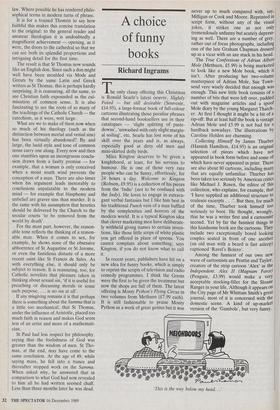What faith teaches us is not impossible
Piers Paul Read
ST THOMAS AQUINAS'S SUMMA THEOLOGIAE: A CONCISE TRANSLATION edited by Timothy McDermott
Eyre & Spottiswoode, f40, pp.651
Modern times for the modern man begin either with the Enlightenment or, at the earliest, with the Renaissance. The Middle Ages appear both too distant and too different to have any bearing on our present lives. Yet, as Timothy McDermott points out in his preface to his concise translation of the Summa Theologiae, we continue to admire the great Gothic cathedrals and take for granted the univer- sities which were mediaeval foundations.
The Summa is the intellectual equivalent of York Minster — a huge and magnificent statement of Christian belief unequalled in the centuries which followed. Its architect, Aquinas, was the son of an Italian count
who, though destined to become a Bene- dictine monk, chose instead to join the recently established order of preaching friars, the Dominicans. He studied under St Albert the Great in Cologne and later taught in Paris, Rome and Naples.
It was a time of intellectual confusion when Christian faith was grappling with the rediscovered philosophy of ancient Greece — particularly that of Aristotle which had filtered into western Europe in Arabic translations and through the influence of the Muslim philosopher Averroes.
Some theologians such as Siger of Bra- bant took the view that philosophy and theology were two distinct disciplines that could not be brought together. It was the achievement of Aquinas to integrate the two — not proving, philosophically, what were matters of faith but demonstrating by reason 'that what faith teaches us is not impossible'.
If his Summa has seemed inaccessible to all but theologians and seminarians in the past, it is partly because it was appropri- ated as the rule book of the Roman Catholic Church at the counter- Reformation (it was placed beside the Bible on the altar at Trent); and partly because its style and structure make it difficult for the modern reader. The origin- al work follows the pattern of mediaeval debate — questions divided into objec- tions, each of which is answered by a response.
What Timothy McDermott has done with great skill is rearrange the whole work into a continuous text with sentences, paragraphs, chapters and parts of a kind familiar to the contemporary reader; and guide us through the work with intelligent, unobtrusive introductory comments to each of the different sections. He has also cut certain passages such as those discus- sing details of Old Testament ritual and law. Where possible he has rendered philo- sophical terms in modern turns of phrase. It is for a trained Thomist to say how faithful this makes this concise translation to the original: to the general reader and amateur theologian it is undoubtedly a magnificent achievement — opening, as it were, the doors to the cathedral so that we can see both its splendid proportions and intriguing detail for the first time.
The result is that St Thomas now sounds like an English don. Since such a don might well have been moulded via Mods and Greats by the same Latin and Greek writers as St Thomas, this is perhaps hardly surprising. It is reassuring, all the same, to see Christian faith expounded as the cul- mination of common sense. It is also fascinating to see the roots of so many of the teachings of the Catholic Church — the catechism, as it were, writ large.
What are we to make of them now when so much of his theology (such as the distinction between mortal and venial sins) has been virtually abandoned? By. and large, the lucid style and tone of common sense carry one along. Every now and then one stumbles upon an incongruous conclu- sion drawn from a faulty premise — for example, that a woman is only conceived when a moist south wind prevents the conception of a man. There are also times when his argument leads inexorably to conclusions unpalatable to the modern mind — for example that blasphemy and unbelief are graver sins than murder. It is the same with his assumption that heretics should be delivered by the Church to the secular courts 'to be removed from the world by death'.
For the most part, however, the reason- able tone reflects the thinking of a reason- able man. When it comes to sex, for example, he shows none of the obsessive abhorrence of St Augustine or St Jerome, or even the fastidious distaste of a more recent saint like St Francis de Sales. As with everything else, it should only be subject to reason. It is reassuring, too, for Catholic novelists that pleasure taken in thinking about sexual sin, 'if it is useful for preaching or discussing morals or some such purpose, ... is no sin at all'.
If any misgiving remains it is that perhaps there is something about the Summa that is a little too mechanical; that St Thomas, under the influence of Aristotle, placed too much faith in reason and makes God seem less of an artist and more of a mathemati- cian.
St Paul had less respect for philosophy, saying that the foolishness of God was greater than the wisdom of men. St Tho- mas, at the end, may have come to the same conclusion. At the age of 49, while saying mass, he fell into a trance and thereafter stopped work on the Summa. When asked why, he answered that in comparison to what God had now revealed to him all he had written seemed chaff. Less than three months later he was dead.



















































 Previous page
Previous page